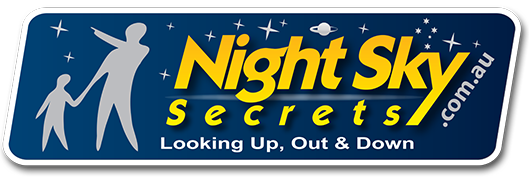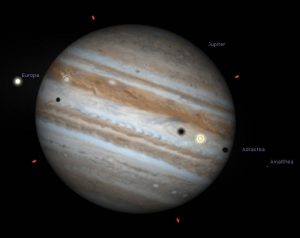The Planets
Mercury returns to our morning skies rising 2 hours ahead of the sun in June. It presents a large (for Mercury) bright crescent to observe at this time making it one of the best times of the year to check it out ! However fleet footed Mercury has Shrunk to almost 1/2 the size of it’s June appearance when it reappears in the Evening sky in Mid July along with Venus as you shall soon see.
Venus is entirely lost from our view in June & is in fact in conjunction with the sun. However in July it returns mid month & has a close conjunction at just 0.5 Deg Apart on the 17th of July with the aforementioned Mercury. However at only 2deg above the western Horizon , you will need a sharp eye and a clear western Horizon.
Mars is still the star of the show this month having just been at its closest point in Late May. It’s still at magnitude -2. Features like the massive Hellas Basin at 2300km across & Syrtis Major should be easily visible even with a small telescope. Mars is also within 0.5 Deg (less than a finger width) of Globular cluster NGC 5897 from the 25th for 10 days. Make sure you check out Mars as it will be another 2 years until you get another chance to see Mars this well. As we move into July, this is your last chance to see Mars as a reasonable sized disk. This month however is a great time to see the South Polar Cap of Mars at its best.
Jupiter, shrinks somewhat from opposition, but is still just a touch brighter than Mars mid month at Magnitude -2.2 .With its short rotational period of just 9.9 hours and the constant dance of its moons you could watch it all night and see the entire planet & if you are lucky you may even get to see a jovian moon transit ! July is the last chance to see Jupiter for the next couple of months at a good altitude before it moves into conjunction with the sun in September.
Saturn has its turn to come to opposition in June on the 2nd and at an even Magnitude 0.0 still quite bright and only outshone by the 4 brightest stars in the night sky, 2 of which are easily visible. Alpha Centuri (our closest star) in the southern Sky and Arcturus in the Northern sky. Saturn continues to be a great sight in July as it is only just past opposition and is high in the evening sky in the Constellation Ophiuchus the Serpent Bearer, close to the Scorpius border.
Uranus Is visible in the morning skies, rising in Pisces around 2am, where it remains throughout July.
Neptune in Aquarius is visible from 11pm and begins its retrograde motion from the 14th. Slow moving Neptune will remain in Aquarius in July.
Comets: Comet C/2013 X1 will make an appearance in Aquarius as the month of June begins before moving into Pisces Austrinus in the 1st week. I mention this one as it is predicted to be 9th Magnitude, putting it in Reach of even a small aperture scope. By July it has migrated into the constellations Norma then Lupus before entering the constellation of Centaurus where it spends the rest of the month. Who knows, it might even brighten unexpectedly !
Meteor Showers
While there are no major meteor showers in June there is however the Alpha Capricornids in July peaking around the 30th. While not great in number (only 5 / Hour) they are renowned for spectacular long slow meteors with a higher than average number of fireballs. The Southern delta Aquarids peaking on the 28th to the 30th at 15 (mostly Feint) meteors/hr make the 30th a great date to be looking out for meteors !
Observing Equipment Advice
Naked Eye Viewing: This is the best way to see Meteor Showers, the board sweep of the Milky Way & track satellites across the night sky. Choose as dark site and a comfortable reclining position. This is FREE and just takes a bit of effort 🙂
Big Star clusters: we are talking about groupings of stars that are beyond a fuzzy blob, these are things like the clouds of Magellan, the Pleiades & a few selected nebulous regions. These are best seen with a pair of 7x to 10x Magnification binoculars with a 50mm lens. Prices start from around $100.
Fuzzy Blobs: You can’t make out what they are but you think they might be interesting ? These are best seen with a wide field telescope, starting price is around $250. These scopes gives you a nice contrast against the blackness of space.
The Invisible: Galaxies, faint nebula & planetary details, this is where scopes 6” in aperture and above come into play, these start at around $400 and how big you go is only limited by portability and budget (The biggest have 48” or 1.2m mirrors !)
You can find all these scopes and more at NightSkySecrets telescope page.

